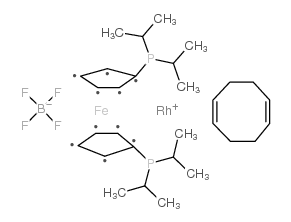(1Z,5Z)-cycloocta-1,5-diene,cyclopentyl-di(propan-2-yl)phosphane,iron,rhodium,tetrafluoroborate
Modify Date: 2024-01-02 17:02:55

(1Z,5Z)-cycloocta-1,5-diene,cyclopentyl-di(propan-2-yl)phosphane,iron,rhodium,tetrafluoroborate structure
|
Common Name | (1Z,5Z)-cycloocta-1,5-diene,cyclopentyl-di(propan-2-yl)phosphane,iron,rhodium,tetrafluoroborate | ||
|---|---|---|---|---|
| CAS Number | 157772-65-1 | Molecular Weight | 716.20500 | |
| Density | N/A | Boiling Point | N/A | |
| Molecular Formula | C30H48BF4FeP2Rh | Melting Point | N/A | |
| MSDS | N/A | Flash Point | N/A | |
| Name | (1Z,5Z)-cycloocta-1,5-diene,cyclopentyl-di(propan-2-yl)phosphane,iron,rhodium,tetrafluoroborate |
|---|---|
| Synonym | More Synonyms |
| Molecular Formula | C30H48BF4FeP2Rh |
|---|---|
| Molecular Weight | 716.20500 |
| Exact Mass | 716.16600 |
| PSA | 27.18000 |
| LogP | 10.69330 |
|
Section 1: Product Identification Chemical Name:1,1'-Bis(di-i-propylphosphino)ferrocene(1,5-cyclooctadiene)rhodium (I) tetrafluoroborate, min. 98% CAS Registry Number:157772-65-1 Formula:[[(C3H7)2PC5H4]2Fe](C8H12)Rh+BF4- EINECS Number:none Chemical Family:Organophosphine complex Synonym:1,1'-Bis(di-i-propylphosphanyl)ferrocene(1,5-cyclooctadiene) rhodium (I) tetrafluoroborate
Section 2: Composition and Information on Ingredients IngredientCAS NumberPercentACGIH (TWA)OSHA (PEL) Title compound157772-65-1100%2.5mg/m3 (as F)2.5mg/m3 (as F) Section 3: Hazards Identification Emergency Overview:Irritating to the respiratory tract, skin and eyes. May be harmful if swallowed. Primary Routes of Exposure:Ingestion, skin Eye Contact:Causes slight to mild irritation of the eyes. Skin Contact:Causes slight to mild irritation of the skin. Inhalation:Irritating to skin, eyes and respiratory tract. Ingestion:No information on the physiological effects of ingestion. Acute Health Affects:Irritating to skin, eyes and respiratory tract. Chronic Health Affects:There is no information on the effects of long-term exposure. NTP:No IARC:No OSHA:No SECTION 4: First Aid Measures Immediately flush the eyes with copious amounts of water for at least 10-15 minutes. A victim may need Eye Exposure: assistance in keeping their eye lids open. Get immediate medical attention. Wash the affected area with water. Remove contaminated clothes if necessary. Seek medical assistance if Skin Exposure: irritation persists. Remove the victim to fresh air. Closely monitor the victim for signs of respiratory problems, such as difficulty Inhalation: in breathing, coughing, wheezing, or pain. In such cases seek immediate medical assistance. Seek medical attention immediately. Keep the victim calm. Give the victim water (only if conscious). Induce Ingestion: vomiting only if directed by medical personnel. SECTION 5: Fire Fighting Measures Flash Point:not applicable Autoignition Temperature:none Explosion Limits:none Extinguishing Medium:carbon dioxide, dry powder or foam If this material is involved in a fire, fire fighters should be equipped with a NIOSH approved positive pressure Special Fire Fighting Procedures: self-contained breathing apparatus and full protective clothing. Hazardous Combustion andIf involved in a fire this material may emit toxic organic fumes, and corrosive fumes of hydrofluoric and Decomposion Products:phosphoric acids. Unusual Fire or Explosion Hazards: No unusual fire or explosion hazards. SECTION 6: Accidental Release Measures Spill and Leak Procedures:Small spills can be mixed with powdered sodium bicarbonate, lime, or calcium carbonate and swept up. SECTION 7: Handling and Storage Store in a tightly sealed container. Keep away from heat and direct sunlight. Prolonged exposure to air may Handling and Storage: result in the degradation of the product. SECTION 8: Exposure Controls and Personal Protection Eye Protection:Always wear approved safety glasses when handling a chemical substance in the laboratory. Skin Protection:Wear protective clothing and gloves. Ventilation:Material may form a fine dust. If possible, handle the material in an efficient fume hood. If ventilation is not available a respirator should be worn. The use of respirators requires a Respirator Respirator: Protection Program to be in compliance with 29 CFR 1910.134. Ventilation:Material may form a fine dust. If possible, handle the material in an efficient fume hood. Additional Protection:No additional protection required. SECTION 9: Physical and Chemical Properties Color and Form:orange-brown pwdr. Molecular Weight:716.21 Melting Point:no data Boiling Point:no data Vapor Pressure:no data Specific Gravity:no data Odor:none Solubility in Water:insoluble SECTION 10: Stability and Reactivity Stability:air sensitive Hazardous Polymerization:no hazardous polymerization Conditions to Avoid:prolonged contact with air Incompatibility:oxidizing agents and halogens Decomposition Products:carbon dioxide, carbon monoxide, phosphorus pentoxide, hydrofluoric acid, and organic fumes. SECTION 11: Toxicological Information RTECS Data:No information available in the RTECS files. Carcinogenic Effects:no data Mutagenic Effects:no data Tetratogenic Effects:no data SECTION 12: Ecological Information Ecological Information:No information available SECTION 13: Disposal Considerations Disposal:Dispose of according to local, state and federal regulations. SECTION 14: Transportation Shipping Name (CFR):Non-hazardous Hazard Class (CFR):NA Additional Hazard Class (CFR):NA Packaging Group (CFR):NA UN ID Number (CFR):NA Shipping Name (IATA):Non-hazardous Hazard Class (IATA):NA Additional Hazard Class (IATA):NA Packaging Group (IATA):NA UN ID Number (IATA):NA SECTION 15: Regulatory Information TSCA:Not listed in the TSCA inventory. SARA (Title 313):Title compound not listed. Second Ingredient:none SECTION 16 - ADDITIONAL INFORMATION N/A |
| Risk Phrases | 36/37/38 |
|---|---|
| Safety Phrases | 26-36/37/39 |
| 1,1'-Bis(di-i-propylphosphino)ferrocene(1,5-cyclooctadiene)rhodium(I) tetrafluoroborate |
| 1,1'-BIS(DI-ISOPROPYLPHOSPHINO)FERROCENE(1,5-CYCLOOCTADIENE)RHODIUM(I) TETRAFLUOROBORATE |
| [RH COD DIPFC]BF4 |